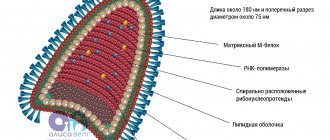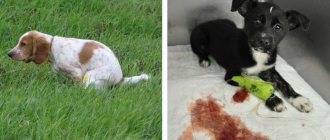Dog rabies photo
Rabies is a very dangerous and fatal disease in dogs . The animal becomes infected with a virus that causes acute attacks and damages the nervous system. As a result, the dog may be afraid of water, nervousness appears, and soon muscle paralysis, suffocation and death occur. That is why it is important to recognize the disease in time.
Content
1. Rabies - definition 2. Possible routes of infection 3. Features of the incubation period 4. Symptoms and signs indicating that a dog is infected with rabies 5. How can rabies be detected in an animal 6. Is it possible to cure rabies 7. Basic preventive measures, organization of treatment 8. Correct solution 9. Video
Rabies in dogs is a dangerous viral disease that is practically untreatable and, after the appearance of characteristic symptoms, almost always ends in death. The deadly virus is transmitted through a bite or close contact between animals, and people are also at risk.
The dog owner should know all the main symptoms of rabies in the dog, as well as the procedure to follow if any suspicion arises. Delay in this case is unacceptable, since not just the health of the animal is at stake, but also its very life. In addition, any dog owner should be able to take first aid measures for people bitten by an infected dog. Whether a person gets sick directly depends on correct and timely exposure!
Violent form of the disease
In fact, it is the active stage of the course of the virus. This period has sub-stages. There are three of them. At first, the dog avoids communication and stops responding to its name. If you still approach the dog, he whines and caresses. The weasel becomes aggressive in the second stage of violent rage. Signs and symptoms in a dog during this period are unreasonable:
- Irritability
- Shyness
- Attacks not only on living beings, but also on inanimate objects
In the third stage of violent rage, the larynx is blocked. The result is wheezing and drooping of the lower jaw. Saliva begins to flow freely from the mouth, releasing in increased quantities. Foam forms near the mouth. The brutal creature constantly howls.
The last stage of the violent course of the disease is called paralytic or depressive by veterinarians. It is preceded by a manic stage, and the first stage is called prodromal or melancholic. The total duration of violent rabies is 5-13 days.
Rabies - definition
Rabies in dogs is a viral infectious disease that occurs in an extremely severe form and is characterized by progressive damage to the brain, spinal cord, central nervous system and, in the vast majority of cases, leads to death. It is possible to counteract a deadly virus only if the very first symptoms of the disease are identified in a timely manner and all necessary countermeasures are taken.
The most important responsibility of every dog owner is to know and be able to distinguish the slightest signs of a viral disease.
There are the following main types of virus:
| Street (Wild) | It is he who poses the greatest danger, circulating and being transmitted from one individual to another in the natural habitat of animals (primarily dogs). |
| Fixed | It does not cause disease and is used by doctors to develop and obtain an antidote - special vaccines. |
The virus multiplies first in the cells of the medulla oblongata, then spreads to the lumbar back and affects the entire central nervous system of the dog. The causative agent is a specific RNA; it can spread everywhere, maintaining its activity and danger at low temperatures, as well as under the influence of a number of chemically active substances and drugs.
What can definitely destroy the virus is high temperatures; the resistance of hydrophobia is sharply lost under the influence of direct sunlight.
Atypical disease
In some sources, rabies is identified as a separate subspecies. Officially, an atypical disease is synonymous with a silent form of the disease. It is called atypical because of the blurred picture of symptoms. While violent rabies is recognized even by amateurs, quiet rabies is also confused by veterinarians.
In addition to Ausenka and gastrointestinal disorders, a nervous type of plague is attributed to rabid dogs. It also leads to paralysis and epileptic seizures. The animal becomes irritable and aggressive. They bring to “clean water”:
- No locking of the lower jaw
- Development of serous conjunctivitis
With rabies, paralysis of the jaw is mandatory; it may not appear at the early stage of the disease, but over time it will help in establishing an accurate diagnosis.
Possible routes of infection
Almost every dog can get rabies, regardless of age, breed, or good health.
At risk are:
- Unvaccinated dogs.
- Small puppies whose immune systems have not yet developed.
- Exhausted creatures weakened by other diseases;
- Individuals living in areas where unfavorable conditions have been recorded precisely due to the widespread spread of the rabies virus.
- Animals living in close proximity to forests and capable of contact with wild animals.
There is an increased risk of “catching” a deadly disease in hunting dogs, including those who take part in hunting foxes, hares, animals living in minks, etc.
As a rule, the rabies virus enters the dog’s body along with the saliva of a sick animal that is a carrier of the disease. Most often, when a healthy dog is bitten by a sick individual.
IMPORTANT!: A rabid dog becomes contagious immediately after it itself has been infected with the virus. It remains extremely dangerous at any of the other stages of disease progression.
During the incubation period, only experienced specialists and attentive owners who take responsibility for the health of their pet are able to clearly identify the problem and organize measures to counter the spread of the disease and cure the infected dog. Infection with rabies can also occur if the saliva of a sick animal gets into a wound, a deep crack in the skin, or onto the mucous membrane of internal organs.
If a pet has not been vaccinated in a timely manner or has not been vaccinated against rabies, it automatically falls into a high-risk group. If infected, such a dog has practically no chance of survival; death is guaranteed. Therefore, you should not wait for the manifestation of any symptoms; the recommendations of experts are clear: it is necessary to carry out periodic vaccination in accordance with the established timing and frequency.
Dog owners should be aware of the fact that the incubation period for rabies occurs with virtually no symptoms, and at the end of it there is a sharp activation of the virus, its accumulation in saliva (one of the reasons for increased salivation) and a sharp manifestation of all the main adverse signs of damage to the nervous system, musculoskeletal system. the animal's locomotor system.
What to do if a dog bites a person
Rabies is classified as a deadly disease for both animals and humans. If you are bitten by an unknown dog, the algorithm of actions is as follows:
- If the blood vessels are not severely damaged, allow the blood to drain a little to remove as much virus particles as possible.
- Next, just as in the case of caring for a bitten pet, you must immediately wash the wound with a concentrated soap solution under pressure. Rinsing will be effective if done within an hour after the bite.
- Then you should treat the wound with hydrogen peroxide, apply a bandage and seek medical help.
- Several years ago, a long course (more than 40 injections) into the abdominal cavity was prescribed against rabies. Now a course of 7 rabies vaccines is prescribed to the shoulder area.
If, after being bitten by a stray dog, a person does not consult a doctor in time, then in case of infection and the first signs of rabies appear, it will not be possible to save him.
Features of the incubation period
A distinctive feature of the onset of the disease is the almost complete absence of any obvious or indirect signs and symptoms. A natural focal infection of the viral type, having entered the animal’s body, is in no hurry to show itself and gradually “accumulates strength.”
The incubation period for this infection does not have a clearly limited time frame and in this way it is similar to many other types of inflammatory viral diseases. On average, it may not be possible to recognize the onset of the disease within 21-42 days. And only after the incubation period has passed, the main symptoms of the disease begin to appear. As noted earlier, unfortunately, after irreversible processes have started in the body. That is why the owner of the animal needs to firmly know and memorize all the obvious and hidden symptoms of the virus.
Of course, the main way of contracting rabies is a bite. But if there are open wounds on the surface of the animal’s skin, they can become the weak point in the body through which the harmful virus penetrates.
Follow us
Find out more about your animal's personality on our social networks
Puppies become infected most quickly; the rabies virus can appear in them as early as 4-6 days of infection.
Adults with strong immunity are able to retain the virus for 2 or even 3 months. But in any case, if there is no vaccination and no treatment and preventive measures are taken, no immune system can cope with the rabies virus on its own.
Why does the infection affect young dogs and puppies faster? Everything is very simple. The virus belongs to the encephalitic category and moves through the body’s neural system at a clearly fixed speed - about 3 mm per hour. It is obvious that the total length of neural circuits in small, young dogs is shorter compared to older, stronger individuals. Accordingly, the disease in large, adult dogs comes out a little later.
Diagnostics
As already mentioned, rabies may not appear for a long time. Also, the symptoms are very similar to those of other serious diseases, such as:
- Nervous plague
- Meningitis
- Encephalomyelitis
- Aujeszky's disease (Pseudorabies)
A preliminary diagnosis is made on the basis of clinical symptoms, anamnesis (questioning of the owner) and data on the rabies situation in the area where the dog was allegedly infected. Epizootic situation data is a complete collection of information on rabies infection: whether similar cases have been registered and how many, whether rabies has been recorded here at all, how long ago and whether it exists now.
The diagnosis must be confirmed by laboratory tests. One of the fastest and most reliable methods for laboratory diagnosis of rabies is the immunofluorescent method.
Symptoms and signs that indicate your dog is infected with rabies
1.
Infection with the rabies virus in a dog manifests itself completely differently than standard, common types of infectious diseases. First of all, the psyche and behavioral characteristics of the dog change. Initially, the animal begins to behave as if it had done something wrong to its owner. The dog bows his head down, his gaze becomes meek, sad, tired. He stops frolicking and playing, tries to sort of retire, avoids contact with people and any other living beings.
Prolonged lying down is the first dangerous symptom that you should pay attention to.
2.
Another indirect sign indicating that the virus has entered the dog’s body is constant thirst. The animal drinks a lot of water, much more than the body requires. By drinking sufficiently large volumes of water, the dog does not experience the same feeling towards food. As a rule, she does not want to eat, and if she does eat any food, its volume remains negligibly small compared to the standard daily diet. In some cases, the animal retains its appetite not only during the incubation period, but also at the moment when the disease begins to manifest itself. The peculiarity of eating is difficulty swallowing food, the dog seems to be choking, but it does not swallow large pieces.
3.
It is worth paying close attention to the behavior of your pet during daily walks. If a dog tries to eat stones, chew wood, tree bark and other objects that are not suitable for ingestion, measures should be immediately taken to diagnose the health condition and, if necessary, treatment.
Remember the following symptoms that may indicate rabies infection and the incubation period in your pet:
- Continuous diarrhea.
- Voice change. He becomes hoarse, hoarse, and over time the situation only gets worse.
- Even in the warm season, the animal may experience severe chills and trembling that spread throughout the body.
- The dog becomes unstable, poorly controlled, disobedient, irritability, fussiness, and restless behavior are evident.
- The dog cannot tolerate bright daytime conditions, especially direct sunlight, and strives for solitude in the dark.
- The fur begins to fall out profusely and this process occurs outside of molting.
Further, when the incubation period is over, the disease comes out and the symptoms of rabies become obvious. The virus has infected the animal's brain and it becomes uncontrollable. Inappropriate behavior, loss of self-control and outbursts of aggression indicate obvious progression of the disease.
The active stage of rabies is characterized by the following symptoms:
- The animal not only avoids water (ponds, puddles, etc.), but experiences uncontrollable fear, real panic;
- Foam and saliva flow from the mouth profusely and uncontrollably (the process of salivation is accompanied by a characteristic evil grin, often distorting the usual, even the most aggressive, features of the expression of the animal’s muzzle in its normal state);
- The dog tries to constantly gnaw his paws, bites his tail;
- Aggressive behavior is possible, accompanied by attacks on other animals and even people.
Immediately before death, the dog stops showing aggression, having neither the strength nor health to do so. The virus completely affects the central nervous system and immobilizes the animal. The hind legs are taken away, and paralysis gradually approaches the brain. Next comes death.
Silent form of the disease
It is confused with Aujeszky's disease. It is also called pseudorabies. The respiratory tract is also affected. With Aujeszky, scabies begins, leading to irritability. The animal's brain suffers no less than with rabies. For a dog there is not much difference. Both viruses are deadly. A person is weakly susceptible to Aujeszky. Rabies affects people with the same intensity as animals.
At one of the stages of the silent form of rabies, the animal refuses to eat, loses weight and becomes weaker
The silent form of the disease lasts 2-4 days. The dog remains docile and eats normally. The virus begins to manifest itself in diarrhea, vomiting, and abdominal pain. This causes rabies to be confused with enteritis and other gastrointestinal tract infections. The infected person loses weight and becomes weaker.
Sometimes, at the quiet stage of rabies, paralysis of the larynx begins. Outwardly, it looks like the dog choked on a bone. This version is supported by coughing and wheezing. Owners of pet dogs often get into their mouths. Not finding the bone there, people become infected through the animal's saliva.
How can you detect rabies in an animal?
Rabies can only be 100% recognized by blood tests. This is the procedure that must be carried out in a veterinary clinic for any of the above symptoms. Here, responsibility for the health and life of the animal lies entirely with the owner. Inattention and irresponsibility are unacceptable. For the period of time while a clinical study of data and blood processing is being carried out, the animal must be placed in an isolated enclosure, where there is no contact with people or other animals.
In the same way, you can check whether your dog is infected without doing a blood test. To do this, the animal is kept in an enclosure for about 2 weeks and its condition is constantly assessed for compliance with or manifestation of any symptoms from those listed earlier. Of course, the second method will not save the pet’s life, but will only protect other animals and people from becoming infected with the most dangerous viral disease.
Abortion disease
It proceeds typically until the acute stage. Then comes a sharp recovery. Its mechanism is a mystery to doctors. The very concept of “abortive” means “aborted.” The disease is aborted in 1-2% of those infected. Perhaps the percentage would have been higher if veterinarians had not euthanized rabid dogs. They are caught and brought for injections in order to protect themselves and other animals from infection.
The abortive form of rabies is also observed in humans. One piece of evidence is a homeless woman’s visit to a Texas hospital. A blood test confirmed she was infected with lyssavirus. This is the scientific name for the causative agent of rabies. However, the disease could be diagnosed by external signs. The disease has entered an acute stage. Meanwhile, the hospitalized woman survived, quickly leaving the hospital due to the inability to pay for medical services.
The existence of abortifacient rabies gives hope, but should not be an incentive to inaction. The virus belongs to the “rebies” group, that is, especially dangerous. It is important to quickly and correctly identify the disease. We'll tell you how to do this in the next chapter.
Can rabies be cured?
No! Despite the fact that the antidote and the technique have been developed for hundreds of years, there has been no effective progress in this matter; the disease continues to manifest itself in cases where conditions are created for this (contact with an infected animal or an animal that is a carrier of a dangerous virus.
All that medicine has achieved in this direction is to develop an effective vaccine that can resist the disease. The vaccinated animal, of course, will get sick after the bite, but it will still have every chance of staying alive and completely restoring the normal functioning of all organs.
What the Law Says
According to Art. 10.6 of the Code of the Russian Federation on Administrative Offenses, dog owners are responsible for violating veterinary rules. Violation of animal quarantine rules or other veterinary and sanitary rules entails the imposition of an administrative fine for citizens in the amount of five hundred to one thousand rubles, for officials - from three to five thousand rubles.
Agree, not such huge amounts. But no amount of money can compare with the danger of losing your beloved pet.
Basic preventive measures, organization of treatment
The best and only true prevention of a possible illness is timely and regular vaccination. Each purebred dog is required to be vaccinated, and compliance with this requirement is checked at various stages, in places where the dog may come into contact with people and pets. For example, at exhibitions, before boarding a train or when transporting by plane.
The probability of a vaccinated dog contracting rabies does not exceed 2%, this is a very high figure! The vaccination process is carried out sequentially and consists of the following main stages:
- At the age of 2 months, the puppy receives its first vaccination.
- After 3 weeks, vaccination is repeated.
- We monitor the change of teeth in young animals and administer a third rabies vaccination.
Your pet can now be considered protected from the deadly rabies virus. But on one condition: the animal vaccination program must continue annually, and the vaccination is done, if possible, at the same time.
If the dog is not vaccinated, but is bitten, vaccination must be carried out as quickly as possible. The life of your four-legged friend depends on it. After administering the drug for at least 2 months, the animal should not be overloaded physically and emotionally. Overheating and hypothermia are also contraindicated. Physical and psychological fatigue of the animal are factors that can create ideal conditions for the rapid spread of the disease.
Recurrent form of the disease
It is characterized by wavy, cyclical development. The transition from the quiet stage to the violent stage is repeated many times. Each time the apathy increases, and the aggression increases. The relapsing form is otherwise called remitting. The concept was originally applied to the daily fluctuations in body temperature during fever. Typically, the fever decreases to 37.3-37.5 degrees with a repeated increase and a subsequent decrease.
At times, cycles of recurrent rabies create the impression of an acute illness followed by a sharp recovery. The impression is false. The dog is doomed. Out of hundreds of individuals, as a rule, only one survives. Moreover, the type of illness in this one individual is defined as abortive. In the next chapter we will find out what this means.
Let's sum it up
Rabies is one of the most terrible diseases of our century; until 2005, it was considered absolutely fatal to humans. It is necessary to remember that the danger of infection always exists: at any time a sick animal can run into your yard, attack a child or your pet walking carefree. In this case, you shouldn't panic. Provide available assistance to the victim and immediately take him to a hospital or veterinary clinic. Speed is the best protection, as it gives a chance for salvation. If you wait until the first symptoms appear, you can consider that the battle is already lost. Be attentive to yourself and the health of your loved ones.
Immunity
- Only cold-blooded animals have natural immunity to rabies.
- Vaccinal immunity is based on the production of antibodies to the viruses that cause the disease.
- According to many researchers, not only humoral immunity (production of antibodies) plays an important role in rabies, but also tissue immunity and the production of virus inhibitors - interferons - by the vaccinated body.
Passive immunization with rabies gamma globulin is the most effective method of treating and preventing rabies.
Development of pathology
Rabies virus is introduced into the body of a healthy dog through the saliva of an infected individual. Infection mainly occurs through bites (the most dangerous are bites on the head and neck), less often through salivation or simply contact through microdamages present on the body of a pet.
The main reservoir of infection is representatives of the wild animal world. Thus, individuals living in forests, as well as in epizootologically disadvantaged regions, pose a danger. The danger of infection exists everywhere, even in urban environments. That is why the owner of a free-ranging dog must be vigilant - his four-legged friend is not immune from meeting an infected stray animal, and, consequently, from his body being affected by rabies.
The mechanism of development of the disease is as follows: the virus rapidly moves along the long processes of neurons and causes damage to the spinal cord and brain. As a result of its activity, irreversible fatal changes occur in brain tissue.
The virus is unstable in the external environment and is sensitive to many disinfectants. Can be stored frozen for up to a year. When boiled at temperatures of 100 degrees or higher, it dies in a matter of minutes.
Prevalence of the disease
Many people think that due to the availability of vaccines, the incidence rate today is quite low. In fact, this is not the case; it’s not for nothing that rabid dogs (you’ve probably seen the photo in the newspapers) are still considered threat No. 1. Today, outbreaks of this terrible disease are observed everywhere. There are no vaccinations in the wild, which means that rabid foxes and wolves periodically emerge from the forests, where they can meet stray animals. Therefore, this problem cannot be solved only by catching stray dogs. The very bad thing is that the disease has a long incubation period, during which the animal is already potentially dangerous. Most often this is 3-6 weeks, but often this time extends to one year. Throughout this period, the animal’s saliva is deadly.











